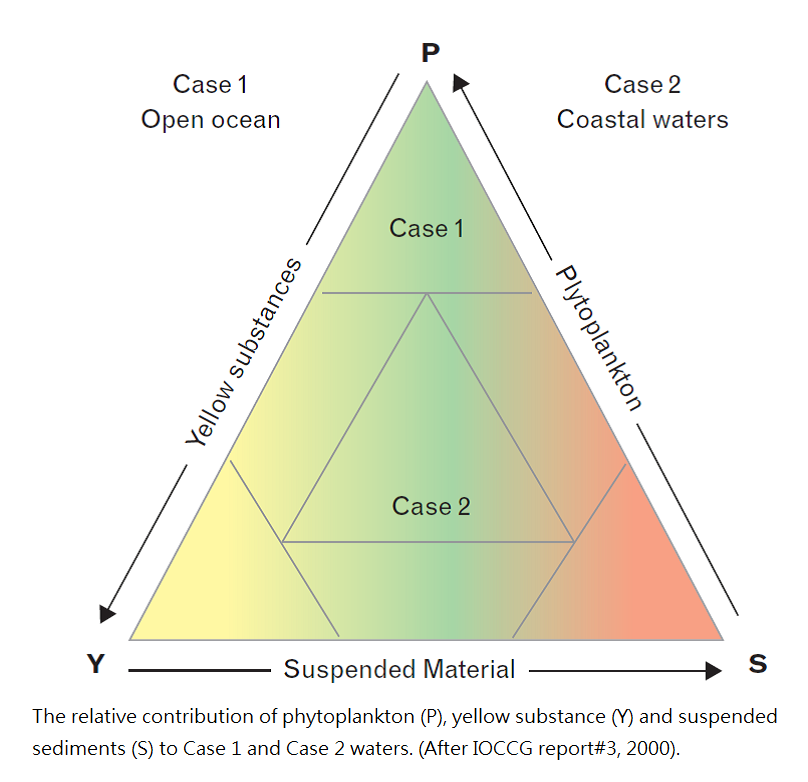Introduction |
Water covers two-third of the earth's surface and supports abundant living organisms and natural resources. The optical properties of water are affected by organic substances, phytoplankton and suspended materials, and on the basis of these parameters the waters are characterized as Case 1 and Case 2. Case 1 waters are phytoplankton dominated and referred to as open ocean waters, while all the others are referred to as Case 2 waters, including coastal and inland waters. Case 2 waters are more complex than Case 1 and contain yellow substance and suspended matter in addition to phytoplankton. Figure 1 shows the Case 1 and Case 2 water in terms of their optical properties and concentrations of yellow substance, phytoplankton and suspended materials. Coastal waters are productive and sensitive marine ecosystems whose effective monitoring and management is an important task for local environmental agencies for protecting and conserving marine resources.

Coastal waters are defined as the water bodies connected with sea, and within which seawater mixes with fresh water from land drainage. Coastal waters are productive and sensitive ecosystems which are significant for economy of a country as they are used for recreation, tourism, fishing and aquaculture. Recently they have become subject to severe environmental pressures in the form of pollutants from urban sewage, industrial waste and agricultural run-off. These pollution sources ultimately affect the marine ecosystem and public health. Therefore, there is a need to monitor coastal waters to prevent their degradation. Generally the term water quality refers to the condition of water, related to its biological, chemical and physical characteristics with respect to its suitability for a specific purpose such as drinking, swimming or sports activities. There are specific standards for water quality against which compliance can be assessed. The most common standards used to assess water quality are related to safety of human contact, drinking water and health of the ecosystem. The biological productivity of coastal waters is measured in terms of Chlorophyll-a (Chl-a) concentration, while physical and chemical properties are determined from the concentration of Suspended Solids (SS). Therefore, it is important to have the knowledge of these water quality parameters. Chl-a is a measure of the phytoplankton biomass and serves as an health indicator of the marine ecosystem, while SS is the non-dissolved matter related to the primary productivity of the water body, sediment transport and more specifically, water clarity. The main objective in understanding the dynamics of coastal regions is to improve the coastal management by reducing the anthropogenic factors. Understanding the processes operating over extensive areas of coastal waters requires the coordinated use of different data sets such as in-situ, remote sensing and numerical modeling data.
Generally the term water quality refers to the condition of water, related to its biological, chemical and physical characteristics with respect to its suitability for a specific purpose such as drinking, swimming or sports activities. There are specific standards for water quality against which compliance can be assessed. The most common standards used to assess water quality are related to safety of human contact, drinking water and health of the ecosystem. The biological productivity of coastal waters is measured in terms of Chlorophyll-a (Chl-a) concentration, while physical and chemical properties are determined from the concentration of Suspended Solids (SS). Therefore, it is important to have the knowledge of these water quality parameters. Chl-a is a measure of the phytoplankton biomass and serves as an health indicator of the marine ecosystem, while SS is the non-dissolved matter related to the primary productivity of the water body, sediment transport and more specifically, water clarity. The main objective in understanding the dynamics of coastal regions is to improve the coastal management by reducing the anthropogenic factors. Understanding the processes operating over extensive areas of coastal waters requires the coordinated use of different data sets such as in situ, remote sensing and numerical modeling data.
Hong Kong, an affluent city with a service-based economy is situated at the mouth of the Pearl River, whose delta region, spanning Hong Kong, Macau and Guangdong Province of China, has undergone lightning-paced industrial and urban development over the last 20 years. Accompanying this, the Pearl River Delta (PRD) region itself has suffered many adverse environmental changes including sea level rise, increased storminess and changes in salinity, sea surface temperature, nutrient, phytoplankton and sediment content, and sediment transport profiles. The economy and activities of the coastal cities of the PRD are directly affected by such changes: increased salinity in the domestic water supply, with adverse effects for residents and tourists alike, has recently gained wide publicity. Hong Kong's coastal environment is complex, exhibiting different types of water in eastern, western and central areas, which makes accurate remote sensing retrieval of water quality parameters challenging. In that context remote sensing, with high frequency of observations over a region of interest and sufficiently fine spatial resolution, can help in classifying coastal ecosystems.
Nazeer M., Nichol J. E. (submitted), Characterization and delineation of optically different zones for the coastal waters of Hong Kong using collocated satellite and in-situ datasets, Remote Sens..
Wong M. S., Lee K. H., Kim Y. J., Li Z. Q., Nichol J. E. & Emerson N. (2007), Modeling of suspended solids and salinity in Hong Kong using Aqua/MODIS satellite images, Korean Journal of Remote Sensing, 23(3): 1-9.